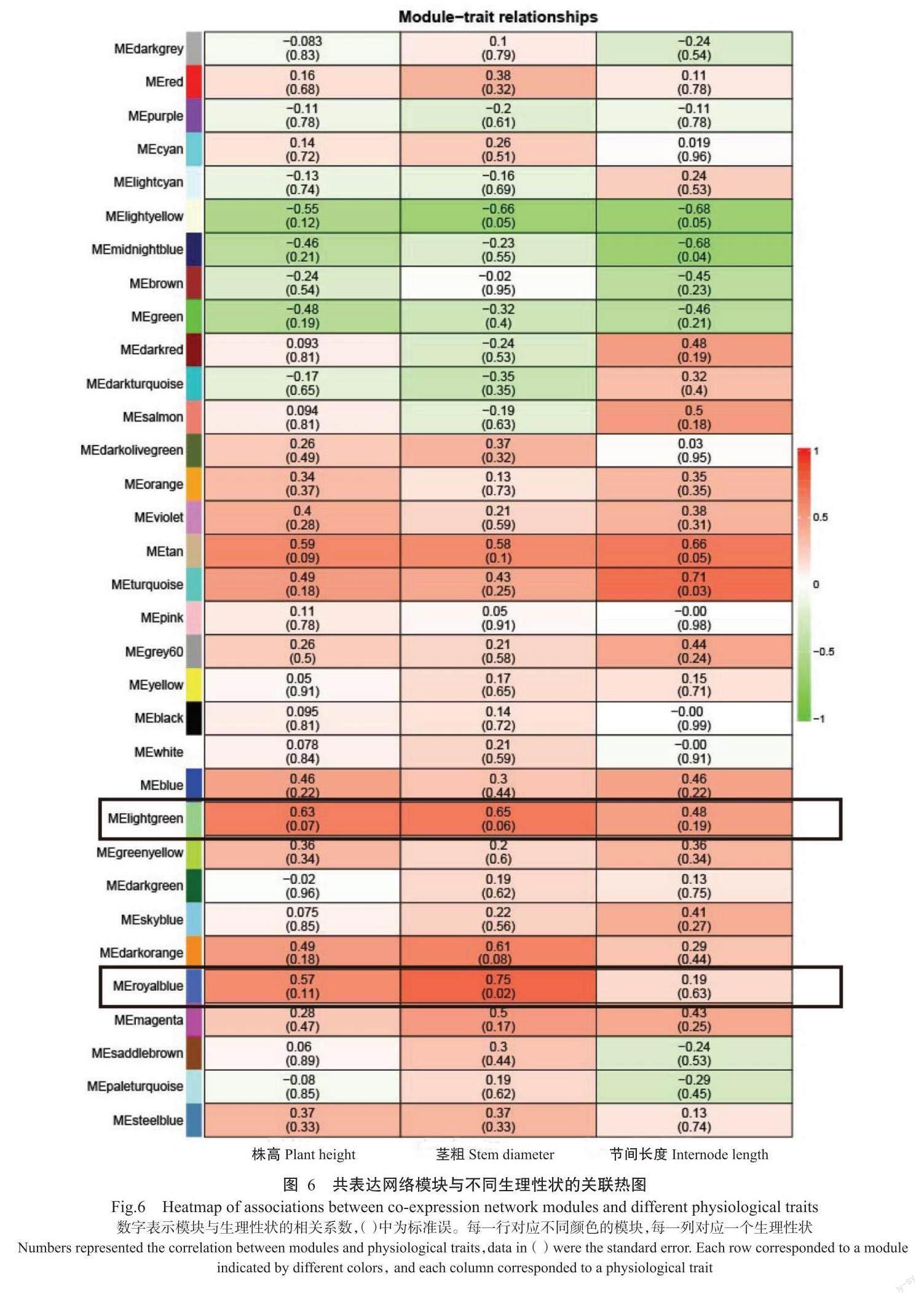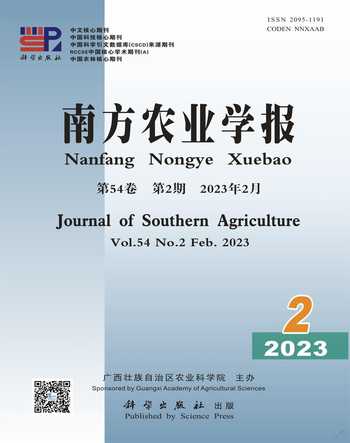番木瓜抗倒伏优势微生物及候选基因筛选
2023-07-22陈仕淼郑剑陆覃昱张继石兰蓉马松琼范兢升甘卫堂
陈仕淼 郑剑 陆覃昱 张继 石兰蓉 马松琼 范兢升 甘卫堂



摘要:【目的】篩选抗倒伏性强的番木瓜根际优势微生物,挖掘番木瓜抗倒伏差异表达的关键基因,为揭示番木瓜抗倒伏机制及相关品种选育提供参考。【方法】试验设常规施肥量处理(每株施用2.5 kg有机肥,CK)、缺肥处理(不施有机肥,WLR)和高有机肥处理(每株施用10 kg有机肥,SLR)3个处理,根据其转录组数据和根际微生物数据,利用加权基因共表达网络(WGCNA)关联分析番木瓜抗倒伏相关的关键基因,并分析根际微生物变化情况。【结果】SLR处理的植株抗倒伏性最强,其次是CK,WLR处理植株的抗倒伏性最差。WLR处理植株的株高、节间长度和茎粗均显著低于CK和SLR处理的植株(P<0.05)。通过微生物组数据分析得到影响抗倒伏性状优势微生物为链丝菌属(Streptomyces)、慢生根瘤菌属(Bradyrhizobium)、RB41菌属及噬几丁质菌属(Chitinophaga)。通过WGCNA分析得到2个与番木瓜抗倒伏性能相关的品蓝模块和淡黄模块,进而对这2个模块构建基因共表达网络,筛选出可能与番木瓜抗倒伏性能密切相关的乙酰辅酶A乙酰转移酶基因(AACT)、聚腺苷酸结合蛋白基因(RBP47)、线粒体输入内膜转位酶亚基基因(TIM9)、钙依赖通道7TM区域基因(HYP1)、韧皮部蛋白质丝网络蛋白基因(SEO)和半胱氨酸蛋白酶抑制剂a基因(CPI)等6个核心基因。核心基因功能分析结果显示,品蓝模块涉及番木瓜萜类代谢调控,而淡黄色模块涉及番木瓜韧皮部生长代谢调控。【结论】根际优势微生物与番木瓜抗倒伏性密切相关,其可通过调控番木瓜茎的生长从而提高抗倒伏性,可作为抗倒伏性强番木瓜品种选育的微生物筛选标记之一。
关键词:番木瓜;加权基因共表达网络(WGCNA);优势微生物;抗倒伏;基因挖掘
中图分类号:S667.9 文献标志码:A 文章编号:2095-1191(2023)02-0336-11
Abstract:【Objective】To screen dominant microorganisms in root of papaya with strong lodging resistance, and to mine key genes of differential expression of papaya lodging resistance, so as to provide reference for revealing mechanism of papaya lodging resistance and related variety breeding selection. 【Method】In the experiment, three treatments were set up, conventional fertilizer application (2.5 kg organic fertilizer per plant, CK), fertilizer deficiency treatment (no organic fertilizer,WLR) and high organic fertilizer treatment (10 kg organic fertilizer per plant, SLR). Based on transcriptome and rhizosphere microorganism data, association analyses of weighted gene co-expression network analysis (WGCNA) were conducted to analyze key genes related to papaya lodging resistance and changes of rhizosphere microorganisms. 【Result】The plants treated with SLR had the strongest lodging resistance, followed by CK, and the plants treated with WLR had the worst lodging resistance. The plant height, internode length, and stem diameter of WLR treated plants were significantly lower than those of CK and SLR treated plants(P<0.05). Through microbiome data analysis, dominant microorganisms that affected the trait of lodging resistance were identified: Streptomyces, Bradyrhizobium, RB41 and Chitinophaga. Two modules related to papaya lodging resistance(royal blue module and light yellow module) were obtained through WGCNA analysis. Weighted gene co-expression networks based on these two modules were established and then 6 core genes possibly related to papaya lodging resistance were screened:acetyl-CoA acetyltransferase (AACT), polyadenylate-binding protein RBP47-like gene (RBP47), mitochondrial import inner membrane translocase subunit gene (TIM9), Calcium dependent channel 7TM region gene (HYP1), phloem protein filament network protein gene (SEO), and cysteine proteinase inhibitor a-like gene(CPI). Functional analysis of the core genes showed that the royal blue module was involved in papaya terpenoid metabolism regulation, while the light yellow module was involved in papaya phloem growth regulation. 【Conclusion】Dominant rhizosphere microorganisms are closely related to papaya lod-ging resistance, and as they can strengthen lodging resistance through regulating papaya stem growth, they can be taken as one of the microorganism screening markers for highly lodging-resistant papaya breeding.
Key words: Carica papaya; weighted gene co-expression network analysis (WGCNA); dominant microorgani-sms; lodging resistance; gene mining
Foundation items: Guangxi Key Research and Development Project (Guike AB19245027); Characteristic Fruit Industry Pioneer Special Project (Guinongkemeng 202204)
0 引言
【研究意义】广西是全国加工型番木瓜(Carica papaya)种植面积和产量最高的省份,但倒伏和花叶病严重影响番木瓜产业的发展。由于加工型番木瓜根系较浅,果实较重,受台风影响易造成倒伏,严重影响番木瓜产量。根际微生物通过改变植物根际生境影响植物内源激素含量变化(鲍根生等,2020),在不同程度上影响着茎的纵向生长(杜加银等,2016)和横向生长(黄文等,2022),进一步影响着抗倒伏性能的强弱。因此,挖掘影响番木瓜抗倒伏能力的优势微生物及相关基因,对提高番木瓜抗倒伏能力具有重要意义。【前人研究进展】已有较多微生物对植物抗倒伏性发挥促进作用的研究报道(Lata et al.,2018;Rana et al.,2020;Devi et al.,2022)。微生物不仅能通过分泌激素促进植物茎部的横向生长(Zhu et al.,2018),同时增强植株的防御能力(Liu et al.,2021),从而增强抗倒伏性能。Patel等(2019)对甘蔗根际微生物进行筛选,结果发现Escherichia sp.VRE34菌株能促进甘蔗株高和茎粗的增加。肖明纲等(2020)研究发现,微生物菌剂能降低水稻株高,提高其抗倒伏能力。白建飞等(2022)研究发现,莫拉维假单胞菌GF-55具有促进玉米苗期生长及增强玉米吐丝抗倒伏性的功能。植物抗倒伏性能的研究主要集中在水稻(Doraira and Ismail,2017;Li et al.,2017)、玉米(Ahmad et al.,2018;Kamran et al.,2018;Zhang et al.,2018)等作物上。但微生物与番木瓜生理性状相互作用的研究(王丽霞等,2017,2022)较少,尚未见有番木瓜根际微生物与抗倒伏性相关的研究。Meng等(2021)研究表明,影响水稻茎秆强度的TUT1、OsCCC1、CFL1和ACL-D等基因在水稻抗倒伏育种中发挥关键作用。Zhao等(2021)研究表明,矮秆基因Rht15基因上调表达可显著降低小麦株高,提高了小麦抗倒伏能力及部分品质性状,但对调控小麦产量相关性状有负面影响。综上所述,粮食作物抗倒伏能力的研究较为深入,而番木瓜抗倒伏能力的机制有待进一步揭示。加权基因共表达网络分析(WGCNA)作为一种联系生理指标与转录组数据的方法,已成为分子生物学研究的有利手段之一。Zaidi等(2020)通过将抗棉花卷叶病的外源基因Mac7转入栽培棉中,经WGCNA分析在共表达网络中发现了9个模块52个核心(Hub)基因,这些基因通过生长素通路及细胞区隔化参与到棉花卷叶病的调控,该结果对了解棉花的抗卷叶病机制及培育耐性植株有重要意义。Wang等(2022)基于猕猴桃果实不同发育成熟段的性状测定结果和转录组数据,通过WGCNA分析鉴定出调控猕猴桃风味代谢的关键转录因子,為风味物质合成途径研究提供了新的解决思路。【本研究切入点】目前鲜见筛选抗倒伏性强的番木瓜根基优势微生物并挖掘番木瓜抗倒伏差异表达基因的研究报道。【拟解决的关键问题】试验设不同施肥量处理,根据其转录组数据和根际微生物数据,利用WGCNA分析挖掘与番木瓜抗倒伏性状相关的关键基因,筛选出影响番木瓜抗倒伏性能的优势微生物,为揭示番木瓜主要抗倒伏性状的分子机制及相关育种提供数据支持。
1 材料与方法
1. 1 试验材料
供试番木瓜品种穗中红,种植于农业农村部番木瓜种质资源圃。主要试剂:NEBNext? UltraTM RNA建库试剂盒、USER Enzyme cDNA合成试剂盒购自新英格兰生物实验室(美国)有限公司;Qubit? RNA 检测试剂盒购自生命技术(美国)有限公司;AMPure XP核酸纯化试剂盒购自贝克曼库尔特(美国)有限公司。主要仪器设备:NanoPhotometer?分光光度计(IMPLEN,美国)、Qubit? 2.0荧光计(Life Technologies,美国)、Bioanalyzer 2100生物分析仪 (Agilent Technologies,美国)和Illumina HiSeq测序仪(Illumina,美国)。
1. 2 抗倒伏生理性状测定
试验设常规施肥量处理(每株施用2.5 kg有机肥,CK)、缺肥处理(不施有机肥,WLR)和高有机肥处理(每株施用10 kg有机肥,SLR)共3个处理。每个处理设3次重复,小区面积20 m2。在种植前将有机肥撒施于小区,翻耕使其混合均匀,之后开始种植番木瓜。待果实膨大期进行采样,每个处理各选3株,测定其抗倒伏生理性状如株高、茎粗等。生理指标按照NY/T 3089—2020《热带作物种质资源描述规范 番木瓜》进行测定。
1. 3 转录组测序及分析
取中间茎秆部分0.1 g左右,液氮冷冻后送武汉迈特维尔生物科技有限公司,采用Illumina HiSeq平台进行转录组测序,共获得9个转录组测序原始数据。各样品Clean data均达7 Gb,Q30碱基百分比在93%及以上。从NCBI数据库(https://www.ncbi.nlm.nih.gov/data-hub/taxonomy/3649/)上下载番木瓜参考基因组及其注释文件,使用 HISAT v2.1.0构建索引,并将Clean reads比对到参考基因组。基于比对结果,使用FPKM(Fragments per kilobase of exon per million fragments mapped)值衡量基因的表达水平,通过P<0.05且|Log2FPKM|≥1为阈值筛选差异表达基因(周陈平等,2022)。
1. 4 微生物组数据收集及分析
取附着在根系表面约1 mm厚的根际土壤1.0 g左右,液氮冷冻,采用CTAB法对其基因组DNA进行提取,使用TruSeq? DNA PCR-Free Sample Preparation Kit进行文库构建,并使用Phusion? High-Fidelity PCR MasterMix(New England Biolabs)实时荧光定量PCR检测构建好的文库,引物序列采用宏基因组测序通用引物,即16S V4引物515F/806R,18S V4引物528F/706R,18S V9引物1380F/1510R(表1)。反应总体系30.0 μL:Phusion? High-Fidelity PCR Master Mix 15.0 μL,0.2 μmol/L上、下游引物各1.0 μL,10 ng/μL模板DNA 1.0 μL。扩增程序:98 ℃预变性1 min;98 ℃ 10 s,50 ℃ 30 s,72 ℃ 5 min,进行30个循环;72 ℃延伸5 min。
利用Qubit? 2.0荧光计和Bioanalyzer 2100系统对文库质量进行评估,参数按照默认设置,筛选文库合格(文库有效浓度高于2 nmol/L)后,使用NovaSeq 6000进行上机测序,共获得9个微生物组测序原始数据。使用R软件(Version 2.15.3)绘制主成分分析(PCA)、主坐标分析(PCoA)和无度量多维标定(NMDS)图。基于已发表文献证据(Louca et al.,2016),将细菌及古菌在环境中的生态作用进行归类,汇总整理为FAPROTAX数据库。基于扩增基因的物种注释结果,对FAPROTAX数据库进行查询,从而获得已有文献支持的物种环境功能信息。
1. 5 共表达网络构建
利用R程序中的WGCNA软件(https://horvath.genetics.ucla.edu/html/CoexpressionNetwork/Rpac-kages/WGCNA/Tutorials/)分别对不同抗倒伏性的番木瓜材料进行共表达网络构建(Zhang and Horvath,2005)。对FPKM进行标准化后将基因表达矩阵输入,使用WGCNA软件中的pickSoftThreashold计算权重值,power值选取为8,使用blockwiseModules构建无尺度网络,混合动态剪切的标准划分模块,参数按照默认设置。利用田间表型数据与无尺度网络构建好的模块进行关联分析,计算相关系数。
1. 6 互作网络构建及分析
利用Cytoscape 3.9.1进行互作网络构建,通过NetworkAnnlyze(undirected)计算网络相关拓扑属性,利用cytoHubba插件(版本0.1)筛选模块核心基因。采用cytoHubba的MCC算法,筛选前5个核心基因,去除无注释的核心基因。
2 结果与分析
2. 1 不同施肥处理对番木瓜抗倒伏及相关性状的影响
由图1可知,SLR处理的植株抗倒伏性最强,其次是CK,WLR处理植株的抗倒伏性最差,表明抗倒伏性与施肥量有关,施肥量量越多,抗倒伏性越强。由表2可知,WLR处理植株的株高、节间长度和茎粗均显著低于CK和SLR处理的植株(P<0.05,下同),而在茎粗方面,3个处理间均存在显著差异;SLR处理的植株除茎粗显著高于CK外,其余2个性状与CK无显著差异(P>0.05)。
2. 2 影响番木瓜抗倒伏性能的差异根际微生物
由PCA分析结果(图2)可知,3个处理之间的菌落丰度存在明显差异,SLR处理单独分为一组,而CK和WLR处理具有相似的结果,无法完全分开。从物种丰度(图3)上看,WLR处理优势微生物属水平主要集中在罗达菌属(Rhodaobacter)、双歧杆菌属(Bifidabacterium)、假黄单胞菌属(Pseudoxanthomo-nas)、Castellabuella、霉菌属(Mycobacterium)、腐植酸杆菌属(Humibacter)、Acidipila及戴氏菌属(Dyella),而SLR处理的微生物优势属水平主要集中于链丝菌属(Streptomyces)、慢生根瘤菌属(Bradyrhizobium)、RB41和噬几丁质菌属(Chitinophaga)等;CK处理的微生物优势属水平主要集中于念珠菌属(Candidatus_Koribacter)、帕尼巴氏菌屬(Paenibacillus)、炭疽菌属(Bacillus)、布氏菌属(Bryobacter)和Jatrophihabitans等。综上所述,影响抗倒伏性状优势微生物为链丝菌属(Streptomyces)、慢生根瘤菌属(Bradyrhizobium)、RB41及噬几丁质菌属(Chitinophaga)。
根据样品在FAPROTAX数据库中的功能注释及丰度信息,选取丰度排名前25的功能及其在每个样品中的丰度信息绘制热图,并从功能差异层面进行聚类分析,结果如图4所示。从功能差异层面的聚类分析结果与PCA分析结果相似。CK处理根际微生物的主要功能为硝酸盐代谢、氮代谢和亚硝酸盐代谢;WLR处理根际微生物的主要功能为光合作用、尿素代谢和木聚糖分解;SLR处理根际微生物的主要功能为氨的有氧代谢。植物对铵态氮的吸收利用效率强于硝态氮,CK处理和WLR处理根际微生物的主要功能集中在硝酸盐代谢及光合作用,而SLR处理根际微生物的主要功能为氨代谢,表明SLR处理改变了微生物菌落结构,增加了土壤细菌对铵态氮的吸收。
2. 3 模块构建及表型关联分析
为了解微生物对番木瓜抗倒伏性的影响,采用WGNCA共构建了33个模块(图5),每一个分支表示一个共表达模块。灰色(grey60)模块包含的是未分配的“游离”基因。将抗倒伏性状与模块进行关联分析,并绘制相关热图,结果(图6)显示品蓝模块基因表达量与茎的横向生长和纵向生长指标均成正相关,且与茎粗相关关系最强(0.75,0.02);同时淡黄模块基因表达量与番木瓜的茎生长负相关,且与节间长度显著负相关(0.75,0.02)。因此,基于品蓝模块和淡黄模块开展深入研究。
2. 4 核心基因的挖掘及共表达网络的构建
筛选连通性>0.1的关联节点构建共表达网络和挖掘核心基因。数据导入cytoscape 3.9.1后对共表达网络进行分析,共表达网络的核心基因利用cytoHubba插件筛选MCC值前5的节点(图7、图8和表3)。通过功能查询发现品蓝模块共表达网络核心基因为乙酰辅酶A乙酰转移酶基因(AACT)和聚腺苷酸结合蛋白基因(RBP47),其功能可能与能量代谢相关,而淡黄模块共表达网络核心基因为韧皮部蛋白质丝网络蛋白基因(SEO)和钙依赖通道7TM区域基因(HYP1),其功能可能与韧皮部合成相关。
3 讨论
土壤生境差异会影响微生物群落的机构(Li et al.,2021)。Yang等(2019)研究表明,生物碳差异会影响植物根际微生物群落差异。根际微生物能通过分泌一些激素类物质促进植物的生长发育。本研究表明,不同施肥处理的番木瓜抗倒伏性存在明显差异,其根际微生物组成也存在明显差异,可能是造成番木瓜抗倒伏性能差异的原因之一。Suárez-Moreno等(2019)研究表明,链丝菌属(Streptomyces)细菌不仅能产生铁载体、吲哚乙酸(IAA)及胞外酶,促进植株的生长,还能通过刺激植物产生激素如赤霉素等影响植物生长,提高其生长力(Amaresan et al.,2018)。慢生根瘤菌属(Bradyrhizobium)细菌能促进宿主植物的固氮及养分吸收,从而促进宿主的生长 (Htwe et al.,2019)。本研究通过田间观察发现,SLR处理能够增强番木瓜的抗倒伏性,其根际优势微生物为链丝菌属(Streptomyces)、慢生根瘤菌属 (Bradyrhizobium)、RB41及噬几丁质菌属(Chitino-phaga),且其主要功能注释为氨的有氧代谢,说明这些优势细菌有可能通过分泌促生物质提高番木瓜抗倒伏性能。但由于对番木瓜根际微生物的研究较少,根际微生物与番木瓜根系的关系上不明确,故要探明微生物影响番木瓜抗倒伏性能的机制,还需找出微生物对番木瓜根系的影响机制。
RBP47基因不仅在植物生长及促进细胞增殖中有重要调控作用(Chen et al.,2018),還参与了转译等细胞过程,促进了种子的萌发及茎的快速增长 (Ferraz Dos Santos,2022)。AACT能激活植物抗逆性反应(姚元枝等,2015;陈雷等,2021),促进脱落酸(ABA)合成水平的升高(Jozwiak et al.,2020)。也有研究表明,AACT对细胞壁多糖乙酰化至关重要(Chen,2017;Zhong et al.,2020)。本研究发现,与茎粗显著相关的品蓝模块中注释到的核心基因为AACT基因和RBP47基因,且根际优势微生物的功能注释到固氮作用,说明番木瓜茎部横向发育的基因可能与番木瓜RBP47蛋白的表达调控及萜类化合物代谢途径相关,微生物可能通过提高光合作用激活番木瓜细胞壁乙酰化机制,从而促进茎的横向生长。
SEO为定位在筛管中的表达蛋白,当植物受损伤后其能在筛管中表达堆积并阻断光合产物的转运(Rüping et al.,2010),且能增强受损部位的机械强度(Knoblauch et al.,2014)。Walker(2022)研究认为,在豆科植物中SEO蛋白受Ca2+调节,通过阻断筛管来阻止蚜虫摄取汁液,且能通过增强筛管的强度及栓塞化来增强茎的机械强度。本研究结果表明,淡黄模块中的核心基因出现了SEO基因,与其表达相关的HYP1基因也是淡黄模块的核心基因,且与其相关的根际微生物功能注释到光合作用和固氮作用,说明韧皮部蛋白质丝网络蛋白的表达可能是影响番木瓜抗倒伏性能的重要因素之一,微生物可能通过提高光合作用和固氮作用促进番木瓜SEO基因和HYP1基因的表达从而影响番木瓜抗倒伏性能,但其作用机理有待进一步研究。
4 结论
链丝菌属(Streptomyces)、慢生根瘤菌属(Bradyrhizobium)等根际微生物可能通过促进固氮作用及分泌促生物质促进番木瓜的生长,从而达到促进抗倒伏性能的作用。品蓝模块是影响茎粗的主要模块,其通过次生代谢途径影响番木瓜的茎粗,而淡黄模块为影响节间长度的主要模块,其中的SEO通路是影响番木瓜节间长度最可能的代谢通路。
参考文献:
白建飞,韩升才,高聚林,于晓芳,青格尔,胡树平,张赛楠,郭江岸. 2022. 内生菌莫拉维假单胞菌GF-55促进玉米生长和提高抗倒伏功能分析[J]. 微生物学通报,49(7):2625-2637. [Bai J F,Han S C,Gao J L,Yu X F,Qing G E,Hu S P,Zhang S N,Guo J A. 2022. Endophytic bacterial strain GF-55 improves the growth and lodging resistance of maize[J]. Microbiology China,49(7):2625-2637.] doi:10.13344/j.microbiol.china.211049.
鲍根生,宋梅玲,王玉琴,刘静,王宏生. 2020. 不同密度甘肃马先蒿寄生和内生真菌互作对紫花针茅内源激素及生物碱含量的影响[J]. 草业学报,29(4):147-156. [Bao G S,Song M L,Wang Y Q,Liu J,Wang H S. 2020. Interactive effects of different densities of Pedicularis kansuensis parasitism and Epichloё endophyte infection on the endogenous hormone levels and alkaloid contents of Stipa purpurea[J]. Acta Prataculturae Sinica,29(4):147-156.] doi:10.11686/cyxb2019313.
陈雷,陈丽娜,王萌,瞿彩丽,邓娟,龚玲,余坤. 2021. 茅苍术乙酰辅酶A酰基转移酶基因(AlAACT)的克隆与序列分析[J]. 中药材,(3):574-579. [Chen L,Chen L N,Wang M,Qu C L,Deng J,Gong L,Yu K. 2021. Cloning and sequence analysis of acetyl-CoA acetyltransferase gene (AlAACT) from Atractylodes lancea[J]. Journal of Chinese Medicinal Materials,(3):574-579.] doi:10.13863/j.issn1001-4454.2021.03.012.
杜加银,胡兆平,侯广军,符连安,李新柱,陈海宁. 2016. 微生物土壤调理剂对辣椒生长及产量的影响[J]. 湖北农业科学,55(22):5781-5783. [Du J Y,Hu Z P,Hou G J,Fu L A,Li X Z,Chen H N. 2016. Effect of microbial soil conditioner on growth and yield of Capsicum annuum L.[J]. Hubei Agricultural Sciences,55(22):5781-5783.] doi:10.14088/j.cnki.issn0439-8114.2016.22.014.
黄文,郭竞,刘慧超,黄晓燕,张舜,应芳卿. 2022. 不同微生物菌剂对番茄产量及品质的影响[J]. 中国瓜菜,35(8):75-78. [Huang W,Guo J,Liu H C,Huang X Y,Zhang S,Ying F Q. 2022. Different microbial agents affect tomato yield and quality[J]. China Cucurbits and Vegetables,35(8):75-78.] doi:10.16861/j.cnki.zggc.2022.0200.
王丽霞,黄大野,何应对,井涛,丁哲利,刘永霞,韩丽娜,吴斌. 2017. 韭菜-番木瓜间作模式对根际土壤可培养微生物、土壤性狀的影响[J]. 湖北农业科学,56(18):3444-3446. [Wang L X,Huang D Y,He Y D,Jing T,Ding Z L,Liu Y X,Han L N,Wu B. 2017. Effects of intercropping between leek and papaya on culturable microorganisms and soil properties in rhizosphere soil[J]. Hubei Agricultural Sciences,56(18):3444-3446.] doi:10.14088/j.cnki.issn0439-8114.2017.18.
王丽霞,殷晓敏,刘永霞,连子豪,王必尊,何应对. 2022. 间作韭菜模式下番木瓜根区微生物群落变化特征[J]. 中国农学通报,38(31):66-76. [Wang L X,Yin X M,Liu Y X,Lian Z H,Wang B Z,He Y D. 2022. Change characteristics of microbial community in the rhizosphere of papaya under papaya-leek intercropping[J]. Chinese Agricultural Science Bulletin,38(31):66-76.] doi:10.11924/j.issn. 1000-6850.casb2021-1043.
肖明纲,杨贤莉,孙兵,迟立勇,张擘,赵北平,李明贤. 2020. 减肥配施微生物菌剂对五优稻四号抗倒性和产量的影响[J]. 安徽农业科学,48(21):156-158. [Xiao M G,Yang X L,Sun B,Chi L Y,Zhang B,Zhao B P,Li M X. 2020. Effect of reduced fertilizer and utilization of microbial inoculant on lodging resistance and yield of Wuyoudao 4[J]. Journal of Anhui Agricultural Sciences,48(21):156-158.] doi:10.3969/j.issn.0517-6611.2020.21.042.
姚元枝,黎晓英,魏麟,伍贤进,刘胜贵,唐玉莲. 2015. 鱼腥草乙酰辅酶A酰基转移酶基因克隆、表达及生物信息学分析[J]. 中草药,46(1):107-111. [Yao Y Z,Li X Y,Wei L,Wu X J,Liu S G,Tang Y L. 2015. Cloning,expression,and bioinformatics analysis of acetyl-CoA C acetyltransferase gene in Houttuynia cordata[J]. Chinese Traditional and Herbal Drugs,46(1):107-111.] doi:10.7501/j.issn.0253-2670.2015.01.021.
周陈平,杨敏,郭金菊,邝瑞彬,李庆萌,杨护,黄炳雄,魏岳荣. 2022. 番木瓜两性株高温条件下花性转变的转录组分析[J]. 果树学报,40(3):457-470. [Zhou C P,Yang M,Guo J J,Kuang R B,Li Q M,Yang H,Huang B X,Wei Y R. 2022. Transcriptome analysis of floral sex reversal induced by high temperature in hermaphroditic papaya (Carica papaya L.) [J]. Journal of Fruit Science,40(3):457-470.] doi:10.13925/j.cnki.gsxb.20220440.
Ahmad I,Kamran M,Ali S,Bilegjargal B,Cai T,Ahmad S,Meng X P,Su W N,Liu T N,Han Q F. 2018. Unicona-zole application strategies to improve lignin biosynthesis,lodging resistance and production of maize in semiarid regions[J]. Field Crops Research,222:66-77. doi:10. 1016/j.fcr.2018.03.015.
Amaresan N,Kumar K,Naik J H,Bapatla K G,Mishra R K. 2018. Chapter 8-streptomyces in plant growth promotion:Mechanisms and role[M]//Singh B P,Gupta V K,Passari A K. New and Future Developments in Microbial Biotechnology and Bioengineering. Amsterdam:Elsevier.
Chen C,Li C L,Wang Y,Renaud J,Tian G,Kambhampati S,Saatian B,Nguyen V,Hannoufa A,Marsolais F,Yuan Z C,Yu K F,Austin R S,Liu J,Kohalmi S E,Wu K Q,Huang S Z,Cui Y H. 2017. Cytosolic acetyl-CoA promotes histone acetylation predominantly at H3K27 in Arabidopsis[J]. Nature Plants,3(10):814-824. doi:10. 1038/s41477-017-0023-7.
Chen J Y,Kalinowska K,Müller B,Mergner J,Deutzmann R,Schwechheimer C,Hammes U Z,Dresselhaus T. 2018. DiSUMO-LIKE interacts with RNA-binding proteins and affects cell-cycle progression during maize embryogenesis[J]. Current Biology,28(10):1548-1560. doi:10.1016/j.cub.2018.03.066.
Devi R,Kaur T,Kour D,Yadav A N. 2022. Microbial consortium of mineral solubilizing and nitrogen fixing bacteria for plant growth promotion of amaranth (Amaranthus hypochondrius L.)[J]. Biocatalysis and Agricultural Biotechnology,43:102404. doi:10.1016/j.bcab.2022.102404.
Doraira D,Ismail M R. 2017. Distribution of silicified microstructures,regulation of cinnamyl alcohol dehydrogenase and lodging resistance in silicon and paclobutrazol media-ted Oryza sativa[J]. Frontiers in Physiology,8:491. doi:10.3389/fphys.2017.00491.
Ferraz Dos Santos L,Santana Silva R J,Falc?o L L,Alves R M,Marcellino L H,Micheli F. 2022. Cupuassu (Theobroma grandiflorum[Willd. ex Sprengel] Schumann) fruit development:Key genes involved in primary metabolism and stress response[J]. Agronomy,12(4):763. doi:10. 3390/agronomy12040763.
Htwe A Z,Moh S M,Soe K M,Moe K,Yamakawa T. 2019. Effects of biofertilizer produced from Bradyrhizobium and Streptomyces griseoflavus on plant growth,nodulation,nitrogen fixation,nutrient uptake,and seed yield of mung bean,cowpea,and soybean[J]. Agronomy,9(2):77. doi:10.3390/agronomy9020077.
Jozwiak A,Sonawane P D,Panda S,Garagounis C,Papadopoulou K K,Abobie B,Massalha H,Almekias-Siegl E,Scherf T,Aharoni A. 2020. Plant terpenoid metabolism co-opts a component of the cell wall biosynthesis machinery[J]. Nature Chemical Biology,16(7):740-748. doi:10.1038/s41589-020-0541-x.
Kamran M,Ahmad I,Wang H Q,Wu X R,Xu J,Liu T N,Ding R X,Han Q F. 2018. Mepiquat chloride application increases lodging resistance of maize by enhancing stem physical strength and lignin biosynthesis[J]. Field Crops Research,224:148-159. doi:10.1016/j.fcr.2018.05.011.
Knoblauch M,Froelich D R,Pickard W F,Peters W S. 2014. SEORious business:Structural proteins in sieve tubes and their involvement in sieve element occlusion[J]. Journal of Experimental Botany,65(7):1879-1893. doi:10.1093/jxb/eru071.
Lata R,Chowdhury S,Gond S K,White Jr J F. 2018. Induction of abiotic stress tolerance in plants by endophytic microbes[J]. Letters in Applied Microbiology,66(4):268-276. doi:10.1111/lam.12855.
Li A Y,Wang Y P,Wang Y J,Dong H L,Wu Q X,Mehmood K,Chang Z Y,Li Y,Chang Y F,Shi L J,Tang Z X,Zhang H. 2021. Microbiome analysis reveals soil microbial community alteration with the effect of animal excretion contamination and altitude in Tibetan Plateau of China[J]. International Soil and Water Conservation Research,9(4):639-648. doi:10.1016/j.iswcr.2021.04.011.
Li F C,Xie G S,Huang J F,Zhang R,Li Y,Zhang M M,Wang Y T,Li A,Li X K,Xia T,Qu C C,Hu F,Ragauskas A J,Peng L C. 2017. OsCESA9 conserved‐site mutation leads to largely enhanced plant lodging resistance and biomass enzymatic saccharification by reducing cellulose DP and crystallinity in rice[J]. Plant Biotechnology Journal,15(9):1093-1104. doi:10.1111/pbi.12700.
Liu H W,Li J Y,Carvalhais L C,Percy C D,Prakash V J,Schenk P M,Singh B K. 2021. Evidence for the plant recruitment of beneficial microbes to suppress soil-borne pathogens[J]. New Phytologist,229(5):2873-2885. doi:10.1111/nph.17057.
Louca S,Parfrey L W,Doebeli M. 2016. Decoupling function and taxonomy in the global ocean microbiome[J]. Scien-ce,353(6305):1272-1277. doi:https://doi.org/10.1126/science.aaf4507.
Meng B X,Wang T,Luo Y,Xu D Z,Li L Z,Diao Y,Gao Z Y,Hu Z L,Zheng X F. 2021. Genome-wide association study identified novel candidate loci/genes affecting lod-ging resistance in rice[J]. Genes,12(5):718. doi:10.3390/genes12050718.
Patel P,Shah R,Joshi B,Ramar K,Natarajan A. 2019. Mole-cular identification and biocontrol activity of sugarcane rhizosphere bacteria against red rot pathogen Colletotrichum falcatum[J]. Biotechnology Reports,21:e00317. doi:10.1016/j.btre.2019.e00317.
Rana K L,Kour D,Kaur T,Sheikh I,Yadav A N,Kumar V,Suman A,Dhaliwal H S. 2020. Endophytic microbes from diverse wheat genotypes and their potential biotechnological applications in plant growth promotion and nutrient uptake[J]. Proceedings of the National Academy of Sciences,India Section B:Biological Sciences,90(5):969-979. doi:10.1007/s40011-020-01168-0.
Rüping B,Ernst A M,Jekat S B,Nordzieke S,Reineke A R,Müller B,Bornberg-Bauer E,Prüfer D,Noll G A. 2010. Molecular and phylogenetic characterization of the sieve element occlusion gene family in Fabaceae and non-Fabaceaeplants[J]. BMC Plant Biology,10:219. doi:10.1186/1471-2229-10-219.
Suárez-Moreno Z R,Vinchira-Villarraga D M,Vergara-Morales D I,Castellanos L,Ramos F A,Guarnaccia C,Degrassi G,Venturi V,Moreno-Sarmiento N. 2019. Plant-growth promotion and biocontrol properties of three Streptomyces spp. isolates to control bacterial rice pathogens[J]. Frontiers in Microbiology,10:290. doi:10.3389/fmicb.2019.00290.
Walker G P. 2022. Sieve element occlusion:Interactions with phloem sap-feeding insects. A review[J]. Journal of Plant Physiology,269:153582. doi:10.1016/j.jplph.2021.153582.
Wang R C,Shu P,Zhang C,Zhang J L,Chen Y,Zhang Y X,Du K,Xie Y,Li M Z,Ma T,Zhang Y,Li Z G,Grierson D,Pirrello J,Chen K,Bouzayen M,Zhang B,Liu M C. 2022. Integrative analyses of metabolome and genome-wide transcriptome reveal the regulatory network gover-ning flavor formation in kiwifruit(Actinidia chinensis)[J]. New Phytologist,233(1):373-389. doi:10.1111/nph.17618.
Yang F,Zhou Y,Liu W M,Tang W Z,Meng J,Chen W F,Li X Z. 2019. Strain-specific effects of biochar and its water-soluble compounds on bacterial growth[J]. Applied Scie-nces,9(16):3209. doi:10.3390/app9163209.
Zaidi S S,Naqvi R Z,Asif M,Strickler S,Shakir S,Shafiq M,Khan A M,Amin I,Mishra B,Mukhtar M S,Scheffler B E,Scheffler J A,Mueller L A,Mansoor S. 2020. Molecular insight into cotton leaf curl geminivirus disease resistance in cultivated cotton(Gossypium hirsutum)[J]. Plant Biotechnology Journal,18(3):691-706. doi:10.1111/pbi.13236.
Zhang B ,Horvath S. 2005. A general framework for weighted gene co-expression network analysis[J]. Statistical Applications in Genetics and Molecular Biology,4(1):Article17. doi:10.2202/1544-6115.1128
Zhang Y L,Liu P,Zhang X X,Zheng Q,Chen M,Ge F,Li Z L,Sun W T,Guan Z R,Liang T H,Zheng Y,Tan X L,Zou C Y,Peng H W,Pan G T,Shen Y. 2018. Multi-locus genome-wide association study reveals the genetic architecture of stalk lodging resistance-related traits in maize[J]. Frontiers in Plant Ence,9:611. doi:10.3389/fpls. 2018.00611.
Zhao Z C,Duan S,Hao J M,Cui C G,Yang Y,Condon A G,Chen F,Hu Y G,Chen L. 2021. The dwarf gene Rht15 improved lodging resistance but differentially affected agronomic and quality traits in durum wheat[J]. Field Crops Research,263:108058. doi:10.1016/j.fcr.2021. 108058.
Zhong R Q,Cui D T,Richardson E A,Phillips D R,Azadi P,Lu G,Ye Z H. 2020. Cytosolic Acetyl-CoA generated by ATP-citrate lyase is essential for acetylation of cell wall polysaccharides[J]. Plant and Cell Physiology,61(1):64-75. doi:10.1093/pcp/pcz178.
Zhu S Y,Wang Y Z,Xu X M,Liu T M,Wu D Q,Zheng X,Tang S W,Dai Q Z. 2018. Potential use of high-throughput sequencing of soil microbial communities for estima-ting the adverse effects of continuous cropping on ramie (Boehmeria nivea L. Gaud)[J]. PLoS One,13(5):e197095. doi:10.1371/journal.pone.0197095.
(責任编辑 陈 燕)
